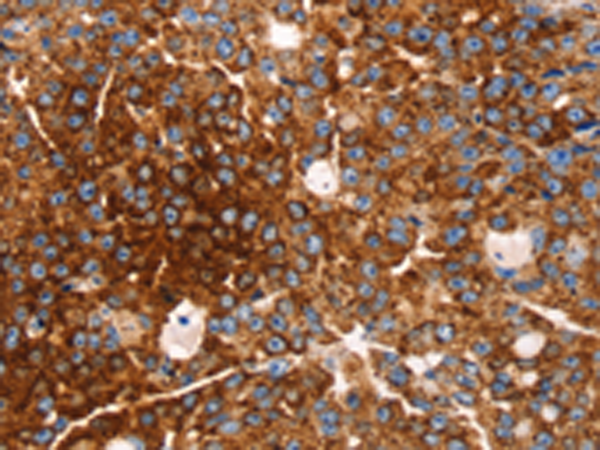

| WB | 咨询技术 | Human,Mouse,Rat |
| IF | 咨询技术 | Human,Mouse,Rat |
| IHC | 1/25-1/100 | Human,Mouse,Rat |
| ICC | 技术咨询 | Human,Mouse,Rat |
| FCM | 咨询技术 | Human,Mouse,Rat |
| Elisa | 1/1000-1/2000 | Human,Mouse,Rat |
| Aliases | DL; ED3; ED5; ED1R; EDA3; HRM1; EDA1R; ECTD10A; ECTD10B; EDA-A1R |
| WB Predicted band size | 49 kDa |
| Host/Isotype | Rabbit IgG |
| Antibody Type | Primary antibody |
| Storage | Store at 4°C short term. Aliquot and store at -20°C long term. Avoid freeze/thaw cycles. |
| Species Reactivity | Human, Mouse |
| Immunogen | Synthetic peptide of human EDAR |
| Formulation | Purified antibody in PBS with 0.05% sodium azide and 50% glycerol. |
+ +
以下是关于EDAR抗体的3篇代表性文献的简要总结:
1. **文献名称**:*Monoclonal antibody targeting EDAR suppresses tooth morphogenesis*
**作者**:Peterková R. et al.
**摘要**:研究通过特异性EDAR单克隆抗体阻断EDAR信号通路,发现其抑制小鼠磨牙形态发生,验证了EDAR在牙齿发育中的关键作用。
2. **文献名称**:*EDAR-induced hypohidrotic ectodermal dysplasia: a clinical and molecular study*
**作者**:Mikkola M.L. et al.
**摘要**:利用EDAR抗体检测患者组织样本,揭示EDAR基因突变导致外胚层发育不良的分子机制,发现信号通路异常影响汗腺和毛囊形成。
3. **文献名称**:*Therapeutic potential of anti-EDAR antibody in ectodermal dysplasia models*
**作者**:Gaide O. et al.
**摘要**:在小鼠模型中,注射EDAR激动型抗体可激活NF-κB通路,部分逆转外胚层发育不良表型(如牙齿和毛发缺陷),提示抗体疗法的可行性。
---
**说明**:以上文献聚焦EDAR抗体的功能研究及潜在治疗应用,覆盖基础机制(牙齿发育)、疾病关联(外胚层发育不良)和抗体干预策略。如需具体文献年份或期刊,可进一步补充关键词检索。
EDAR (Ectodysplasin A Receptor) is a cell-surface receptor belonging to the tumor necrosis factor receptor (TNFR) superfamily. It plays a critical role in ectodermal development, regulating the formation of hair follicles, teeth, sweat glands, and other ectodermal-derived tissues during embryogenesis. EDAR signaling, mediated through its ligand ectodysplasin-A (EDA), activates the NF-κB pathway, influencing cell differentiation and survival. Mutations in *EDAR* are linked to hypohidrotic ectodermal dysplasia (HED), a genetic disorder characterized by sparse hair, missing teeth, and impaired sweat gland development.
EDAR antibodies are tools or therapeutic agents targeting this receptor. In research, they are used to study EDAR's function in development, cancer (e.g., breast, lung), and inflammatory conditions. Therapeutically, anti-EDAR antibodies are explored to modulate EDAR signaling—either as agonists to restore function in HED or antagonists to inhibit overactive pathways in cancers or autoimmune diseases. For instance, agonist antibodies mimicking EDA have shown potential in preclinical models to rescue ectodermal defects. Conversely, blocking antibodies may suppress EDAR-driven oncogenic signaling.
Autoantibodies against EDAR are rare but have been reported in autoimmune disorders, though their clinical significance remains unclear. Challenges in EDAR antibody development include ensuring tissue specificity and minimizing off-target effects. Ongoing studies aim to harness EDAR's role in regenerative medicine, particularly for hair or sweat gland regeneration, highlighting its multifaceted therapeutic potential.
×